HANDLING
Suspension has a big influence on handling, but the true DNA of any bike’s handling character lies within the chassis. While all four Japanese manufacturers abandoned steel in favor of aluminum perimeter chassis designs long ago, KTM and Husqvarna continue to stick with more conventional backbone-style chrome-moly steel designs, citing a more forgiving material that is easier to tune for just the right flex—something that has proven to be a lot more hit-and-miss with aluminum frames.
Honda thinks it got it right on the 2017 CRF450R. The CRF’s all-new aluminum perimeter frame features longer and more gradual bends in the frame spars, which are thicker close to the steering head and gradually thinner as they move away from it. Although it has a more compact feel than its predecessor, the CRF isn’t the lightest machine in the group, checking in at 246.2 lbs. with its trick, 1.6-gallon titanium fuel cell topped to just under the filler neck, but the 58.3-inch wheelbase machine drew positive reviews from our pro and intermediate/expert riders.
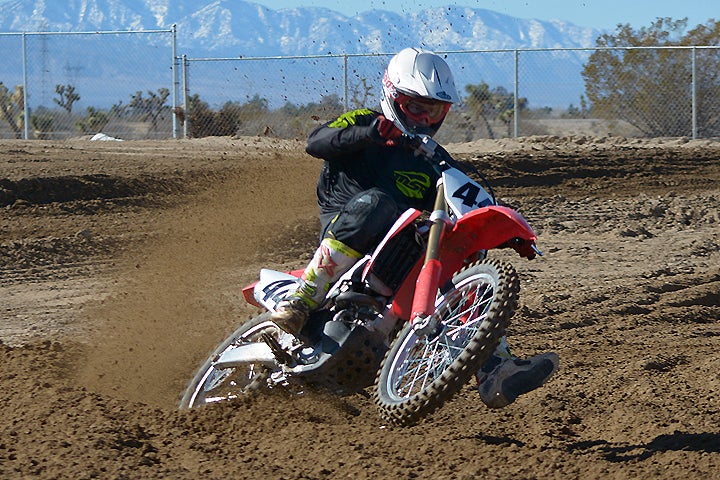
“The new chassis is a big improvement,” Abbatoye said. “In the past, the Honda tended to oversteer, but the 2017 simply doesn’t have that issue. Front end traction is great, and it’s very stable in choppy corners.”
Stover noted that cornering competence is a strong suit of the CRF450R. “Cornering is thoughtless,” Stover said. “It just goes right where you put it every time.” Garvin added that the Honda is very stable and yet really easy to maneuver. “The Honda chassis turns on a dime,” he said. “It doesn’t shake its head, but it does tend to wander a little bit on fast, rough straightaways.”
Turner wasn’t as convinced that the Honda was the best choice for novice riders, but Burch felt that the CRF450R was the best bike in the class when it came to cornering.
“You can put it wherever you want with very little effort,” he said. “It’s also plenty stable in mid-corner, and it really puts the power to the ground smoothly on exit.”
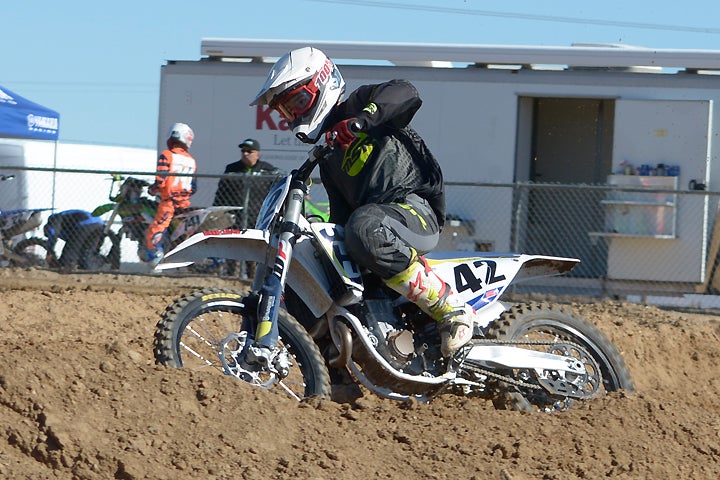
Weighing 238.3 lbs. fully fueled, the Husqvarna FC 450 was the second lightest bike in our test—only the KTM Factory Edition with its feathery Akrapovic exhaust system came in lighter, at 236.3 lbs. There is no difference between the KTM and Husqvarna’s chassis geometry numbers or their 58.5-inch wheelbases, as both use the same hydro-formed, laser-cut and robot-welded main frame, which is designed by WP. The Husqvarna differs from the KTM via its use of a three-piece carbon fiber composite subframe rather than an aluminum subframe, however.
On the track, the Husqvarna was extremely stable in the rough, but our testers once again noted differences between the Husqvarna and the KTM when it came to bending through corners.
“The Husqvarna gives up very little to the other bikes in terms of handling,” Turner said. “It feels a little tall, and wanted to stand up on me a bit more than the others coming out of turns. It wasn’t bad, just not as good as some of the others.”
“Other bikes cornered better,” Abbatoye added. “The Husqvarna’s front end just feels ‘choppered out’ to me.” Garvin, Stover and Burch all gave the Husqvarna more props. Garvin noted that the Husqvarna is plenty stable, turns in nicely and is unflappable through the middle and on exit, and Stover pronounced it very easy to flick into a corner, also mentioning that it doesn’t want to stand up or understeer. “It’s steering is nice and neutral,” he said, while Burch also appreciated the Husqvarna’s overall handling performance. “I didn’t have any issues,” Burch said. “I could put the Husky wherever I wanted in a corner. It was stable and quick-steering through the middle of the corner.”
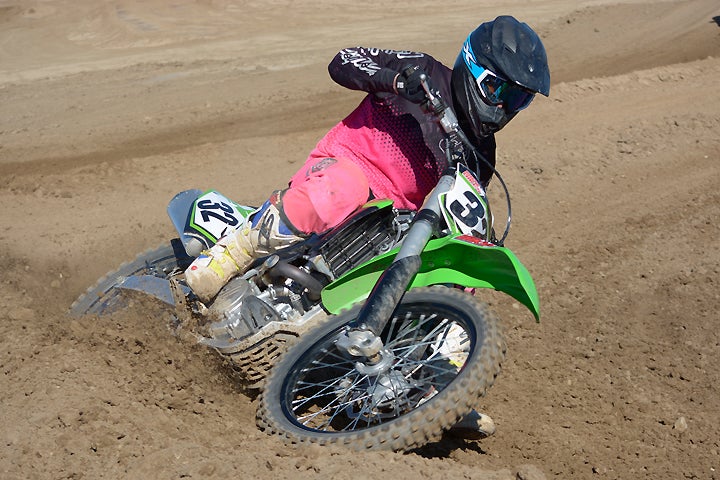
The 2017 KX450F features the same chassis that Kawasaki cooked up when it put the KX450F on a diet back in 2016. The KX’s new frame spars were 6mm slimmer than the 2015’s, and its aluminum subframe boasted thicker walls for improved strength. A lighter but more rigid aluminum swingarm shaved another 7.8 oz. from the chassis, for a total weight loss of 7.5 lbs. While Kawasaki claimed that its handiwork brought the KX’s weight under 240 lbs., our fully fueled 2017 test unit weighed 242.2 lbs.—pretty much in the middle of the road for the class. Its 58.9 inch wheelbase makes it just a tad longer than the competition, and its straight-line stability is a well-known and respected commodity, but the Kawasaki doesn’t seem to be as willing to rail corners as its competition, a point noted by the majority of our test crew.
“It’s one of the better turning 450s that Kawi has produced in the last few years, so it’s a step in the right direction,” Abbatoye said, “but there are definitely better-turning bikes in the class.” Garvin, too, found the KX450F less likely to want to turn on a fresh track, saying. “It tends to like to chase ruts, but it is pretty good through them.”
Stover said, “The KX’s rear end tended to resist following the front end into corners, so you end up having to steer the bike with the rear end a lot,” while Burch said, “For me, the KX was a little hard to hustle into a corner because it wanted to push wide, but once the front end hooked up it steered well.” Turner also noted that the KX doesn’t seem to track through turns with same precision as some of the other machines.
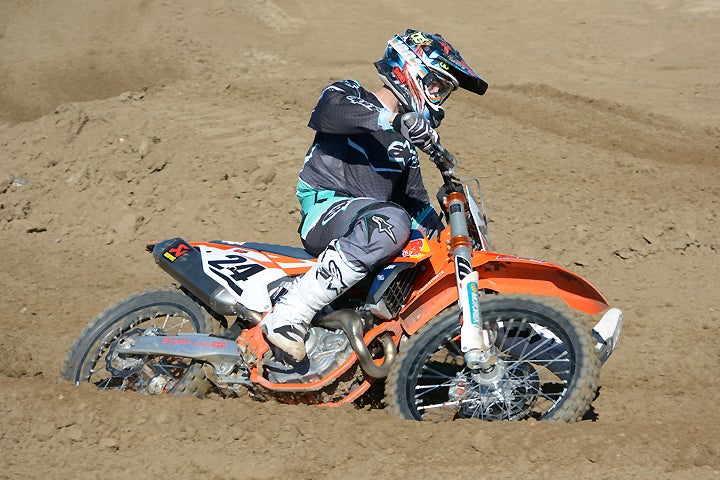
We expected virtually identical comments regarding the KTM’s stability and cornering capability when compared to its sister, the Husqvarna, but for some reason the crew liked it even better. The KTM’s WP-built chrome-moly chassis is as stable as a train over rough ground, and yet it corners with tremendous agility. The KTM is the lightest bike in the class, weighing just 236.3 lbs., but could that difference equate to a machine that is even more agile than its white sibling? Apparently so.
“The KTM turns awesome,” Abbatoye said. “It’s amazing how much traction the front end had even when in flat corners where the track was slick. It falls-in easily, and it feels awesome through the middle and on exit, ruts or no ruts.”
“The KTM handles really well in corners,” Stover agreed. “Basically, the rear follows the front willingly, and the bike stays planted in mid-corner, which also helps it to accelerate off the corner quickly. But I do think that the front end is a little twitchy in a straight line.”
Burch also liked the KTM, but Turner wasn’t as accepting when representing the novice point of view.
“The KTM doesn’t seem quite at the top in terms of agility,” Turner said. “It feels a little tall at the front, and feels like you’re sitting more upright than others. It’s not necessarily a bad thing, as it is still an extremely agile bike. Just not the best of the bunch. Anything it might give up in that department, it gains in stability. It feels like it was harder to make a mistake on the KTM. Aside from me having to keep the front end down [due to the KTM’s power and ability to drive off a corner], it’s very forgiving.”
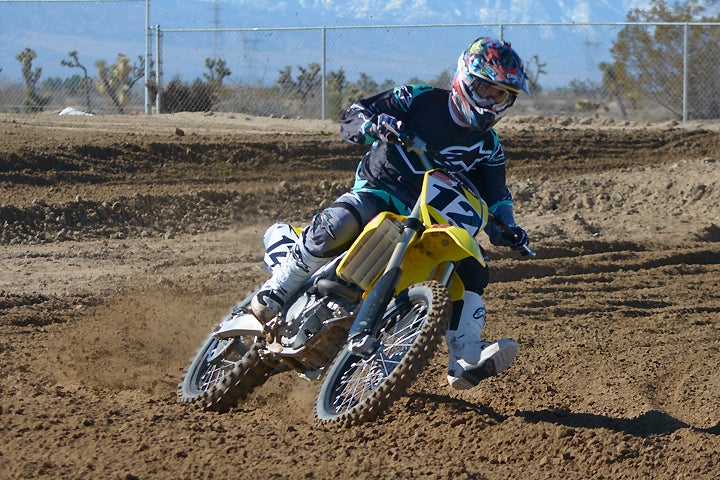
It might be hard to believe that the aging RM-Z450 would be remotely in the hunt with the newer 450s where it pertains to handling, but the Suzuki’s amazing agility is a testament to just how awesome it was when it was first introduced. At 243.7 lbs., it is neither the lightest nor heaviest bike in this comparison, and its 58.9-inch wheelbase is among the longest. But, to a person, our team agreed that while the Suzuki suffers from straight-line stability issues mostly due to its stiff suspension performance, throwing the yellow bike into turns is a different story.
“The Suzuki corners well as long as you don’t have to contend with a square-edged bump or a rut,” Abbatoye said. “Otherwise its stiff suspension action and chassis cause the RM-Z to deflect and get twitchy, and sometimes the front end will lose traction.”
Turner said, “Handling is distinctly fantastic, but you have to like a quick-handing bike,” and Garvin said, “The RM-Z is a great-turning motorcycle even against the more up-to-date bikes in its class. You can put it anywhere on the track, and it stays stable and pulls through any corner.”
Burch noticed a different issue with the RM-Z, however.
“Initial corner entry on the RM-Z is a little tough compared to the others because the chassis is pretty rigid, but it actually suits my riding style really well,” he said. “Its mid-corner performance is great. Once the RM-Z450 settles into a corner, it settles well, and it definitely gets the power to the ground coming off of a corner.”
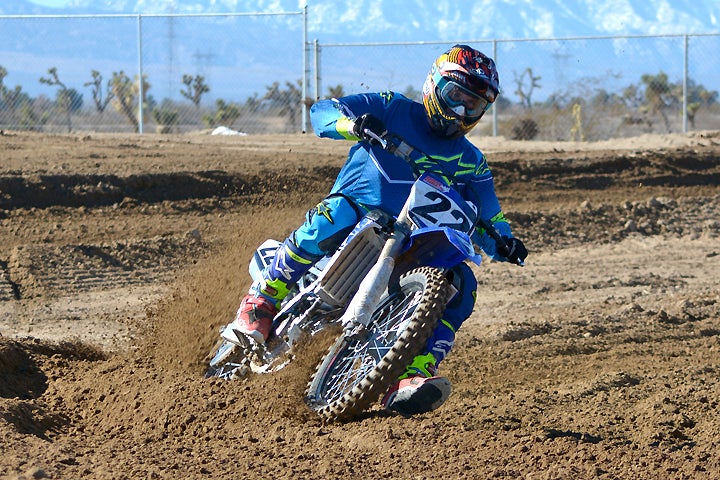
While Yamaha prefers to call its aluminum chassis a bilateral beam aluminum frame to differentiate it from the competition, it is still an aluminum perimeter frame. This arrow-stable generation of the YZ450F chassis has been basically unaltered since 2014, when Yamaha narrowed it by 14mm and tucked the steering head 10mm closer to the rider.
The Yamaha was the tank of the class, pressing the scale to the tune of 249.1 lbs., outweighing the Honda by just under 3 lbs. Our testers had no issues with the Yamaha in straight, fast chop, but what was once considered to be a great-turning machine is now a step behind many of its peers in the steering department.
“The Yamaha is stable, but it has a heavy feel to it,” Abbatoye said. “Coming into a corner, you really have to make sure you are over the front of the bike. It stays in ruts fairly well, but its steering is heavy compared to the other bikes in the class.” Garvin had even more issues with the YZ. “It really has a tendency to push wide in a corner,” he said “I also felt like it could stand to be a little more stable in the middle of the corner.”
Stover, too, felt that handling is where the Yamaha struggles.
“It feels wide and heavy, and while it is stable, it wants to stand up when you’re diving into a corner,” Stover said. “If you’re not really careful with the throttle, it will push wide in the middle of a corner, and it seems to dart around a lot in ruts.”
“The Yamaha sits really high, and I did notice a little head shake at speed,” Burch said. “Corner entry on the Yamaha was also a little difficult, as it was hard to get the bike to settle into a turn.”
 Your Privacy Choices
Your Privacy Choices